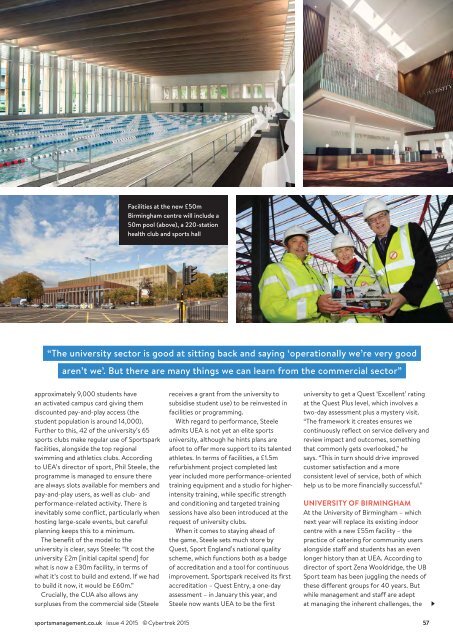EDDIE IZZARD
SM_issue4_2015
SM_issue4_2015
You also want an ePaper? Increase the reach of your titles
YUMPU automatically turns print PDFs into web optimized ePapers that Google loves.
Facilities at the new £50m<br />
Birmingham centre will include a<br />
50m pool (above), a 220-station<br />
health club and sports hall<br />
“The university sector is good at sitting back and saying ‘operationally we’re very good<br />
aren’t we’. But there are many things we can learn from the commercial sector”<br />
approximately 9,000 students have<br />
an activated campus card giving them<br />
discounted pay-and-play access (the<br />
student population is around 14,000).<br />
Further to this, 42 of the university’s 65<br />
sports clubs make regular use of Sportspark<br />
facilities, alongside the top regional<br />
swimming and athletics clubs. According<br />
to UEA’s director of sport, Phil Steele, the<br />
programme is managed to ensure there<br />
are always slots available for members and<br />
pay-and-play users, as well as club- and<br />
performance-related activity. There is<br />
inevitably some conflict, particularly when<br />
hosting large-scale events, but careful<br />
planning keeps this to a minimum.<br />
The benefit of the model to the<br />
university is clear, says Steele: “It cost the<br />
university £2m [initial capital spend] for<br />
what is now a £30m facility, in terms of<br />
what it’s cost to build and extend. If we had<br />
to build it now, it would be £60m.”<br />
Crucially, the CUA also allows any<br />
surpluses from the commercial side (Steele<br />
receives a grant from the university to<br />
subsidise student use) to be reinvested in<br />
facilities or programming.<br />
With regard to performance, Steele<br />
admits UEA is not yet an elite sports<br />
university, although he hints plans are<br />
afoot to offer more support to its talented<br />
athletes. In terms of facilities, a £1.5m<br />
refurbishment project completed last<br />
year included more performance-oriented<br />
training equipment and a studio for higherintensity<br />
training, while specific strength<br />
and conditioning and targeted training<br />
sessions have also been introduced at the<br />
request of university clubs.<br />
When it comes to staying ahead of<br />
the game, Steele sets much store by<br />
Quest, Sport England’s national quality<br />
scheme, which functions both as a badge<br />
of accreditation and a tool for continuous<br />
improvement. Sportspark received its first<br />
accreditation – Quest Entry, a one-day<br />
assessment – in January this year, and<br />
Steele now wants UEA to be the first<br />
university to get a Quest ‘Excellent’ rating<br />
at the Quest Plus level, which involves a<br />
two-day assessment plus a mystery visit.<br />
“The framework it creates ensures we<br />
continuously reflect on service delivery and<br />
review impact and outcomes, something<br />
that commonly gets overlooked,” he<br />
says. “This in turn should drive improved<br />
customer satisfaction and a more<br />
consistent level of service, both of which<br />
help us to be more financially successful.”<br />
UNIVERSITY OF BIRMINGHAM<br />
At the University of Birmingham – which<br />
next year will replace its existing indoor<br />
centre with a new £55m facility – the<br />
practice of catering for community users<br />
alongside staff and students has an even<br />
longer history than at UEA. According to<br />
director of sport Zena Wooldridge, the UB<br />
Sport team has been juggling the needs of<br />
these different groups for 40 years. But<br />
while management and staff are adept<br />
at managing the inherent challenges, the<br />
sportsmanagement.co.uk issue 4 2015 © Cybertrek 2015 57


